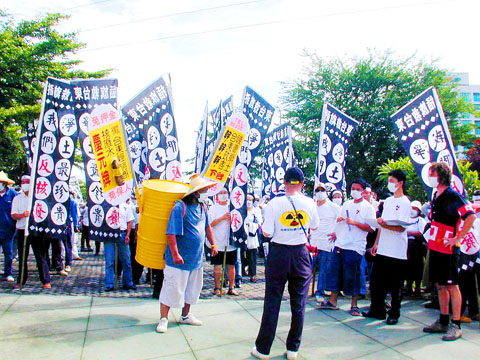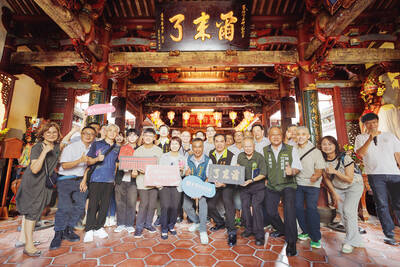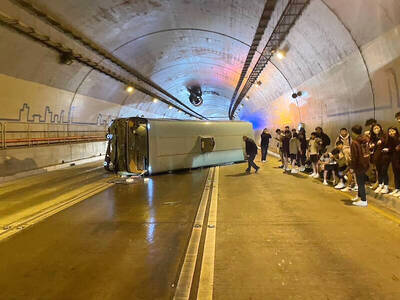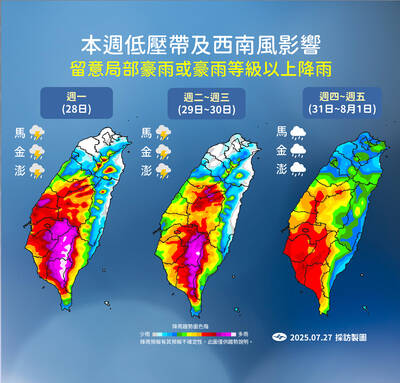After many twists and turns, the Ministry of Economic Affairs has announced a shortlist of three potential sites for a permanent low-level radioactive waste disposal facility.
Under consideration are Taitung County’s Nantien Village (南田村), Pingtung County’s Hsuhai Village (旭海村) and Penghu’s Dongjiyu Islet (東吉嶼) — all remote and sparsely populated communities.
The announcement last Friday of the three sites marked a significant step forward in the country’s controversial drive to build a permanent disposal facility for low-level radioactive waste from its three existing nuclear power plants and the fourth now under construction, as well as radioactive waste from medical, academic, industrial and agricultural institutions.

PHOTO: CHANG TSUN-WEI, TAIPEI TIMES
Over the years, Taiwan has accumulated some 200,000 barrels of such waste, 97,500 of which are stored at a temporary dump opened in 1982 on Orchid Island, also known as Lanyu, off the southeastern coast.
The rest is being kept at the three nuclear power plants in operation and at a national nuclear energy research institute.
Taiwan is one of only six countries among the 34 that utilize nuclear energy that have not set up a permanent disposal facility for low-level waste. At present, 77 such facilities are in operation around the world, with 71 using shallow land disposal and six using cavern disposal.
State-run Taiwan Power Co (Taipower) first faced a site dilemma in the mid-1990s, as the Tao Aborigines on Lanyu protested vociferously over the waste dump in their backyard and insisted that the waste be removed.
The utility twice launched drives to find new sites in the late 1990s, but both failed because of opposition from residents of the potential sites, environmentalists and anti-nuclear energy advocacy groups.
To cope with public health and safety concerns, the government decided to draft legislation that sets siting criteria, processing and suitability requirements and future operational regulations.
The legislation was passed in May 2005, providing Taipower the legal basis to override the objections of angry residents to start site surveys.
The process, however, has remained far from smooth, beset by continued resistance from local residents around potential sites.
After suffering many setbacks, Taipower offered a NT$30 million (US$1 million) subsidy to each village considered a potential site, in exchange for permission to conduct geological surveys and evaluation studies to determine the locations’ suitability to host a disposal facility. Identifying potential sites, however, does not mean establishing a radioactive waste facility will be easy.
Financial incentives provided for in the legislation, along with technological advances, should in theory make it easier for Taipower to find a site and come up with a construction plan that is acceptable to communities.
The law authorizes the government to offer NT$5 billion in subsidies to the locale hosting the site, with 40 percent going to residents of the village, 30 percent to neighboring villages, 20 percent to the county or city in which the village is located and 10 percent reserved for contingency plans.
At the same time, thanks to advances in nuclear waste processing technology, Taiwan now produces only about 300 barrels of low-level radioactive waste each year.
Given this trend, a permanent disposal facility would only have to cover an area of 1km2 to 2km2 to accommodate the existing 200,000 barrels of low-level waste plus another 800,000 barrels estimated to be produced until 2049, when Taipower is expected to decommission its last nuclear power generator.
But the reality of building a waste disposal facility is more complicated and faces severe obstacles.
The law, for example, requires that a countywide referendum be held within six months of the announcement of candidate sites. The referendum will only pass if more than half of the county’s eligible voters turn out to vote and if more than half of them cast a “yes” vote.
That means that even if those residing in the village where the underground facility will be built unanimously embrace the project, it can still be vetoed in the referendum, as many members of the public remain skeptical about the safety of such facilities and their possible environmental impact.
Even if a proposal passes the referendum test, it still faces another crucial hurdle — an environmental impact assessment — before it can be referred to the Executive Yuan for final approval.
Once the Cabinet approves the site, a construction timetable would be worked out and Taipower said it is hopeful that if the process reaches this stage, construction could get under way by 2010 and be completed by 2015.
Reactions from the three potential sites have been mixed.
While the Pingtung County Government and local residents say they will respect the referendum result, many in Penghu, including the county government, have voiced bitter opposition, as people there fear that the disposal facility might derail their dream of turning their island county into a thriving tourist destination with casinos and other modern entertainment facilities.
As for Taitung, the eastern county is caught in a dilemma. Under strong pressure from anti-nuclear groups, the county council rejected screening a draft bill on a countywide referendum in its last session.
With the fate of the legislation uncertain, the county government has become more reserved about the project. And despite Taipower’s handsome financial incentives, half of the county’s residents remain opposed to the project, recent surveys showed.
Over the past two years, Taipower has held more than 100 public meetings at various potential sites in an attempt to assure residents that no matter what kind of facility is built — shallow land burial in excavated trenches or multi-barrier cavern disposal — it will be well protected with many walls to ensure security.
“Villagers have tended to react strongly upon learning that a low-level waste disposal facility might be built in their neighborhood, but some of them softened their opposition after listening to our extensive briefings,” said Liu Chien-lin, a division chief with Taipower’s nuclear back-end management department.
Through long-term communication, some local governments have also turned from vocal opposition to acquiescence or at least refraining from public opposition, the official said.
The Penghu County Government, however, is an exception, with its commissioner and county council speaker reiterating their strong opposition after learning that Dongjiyu was a candidate site.
But Taipower officials are still banking on what they describe as the company’s generous subsidies to emulate South Korea in buying public opinion.
Taiwan is trying to be even more generous than South Korea. In terms of subsidies per nuclear power generator, Taiwan is offering NT$625 million compared with South Korea’s NT$357 million.
Low-level waste refers to items that have become contaminated with radioactive material or that have become radioactive through exposure to neutron radiation.
This waste typically consists of contaminated protective gear, cleaning materials, reactor water treatment residue, equipment and tools and medical items.

The Central Weather Administration (CWA) today issued a "tsunami watch" alert after a magnitude 8.7 earthquake struck off the Kamchatka Peninsula in northeastern Russia earlier in the morning. The quake struck off the east coast of the Kamchatka Peninsula at 7:25am (Taiwan time) at a depth of about 19km, the CWA said, citing figures from the Pacific Tsunami Warning Center. The CWA's Seismological Center said preliminary assessments indicate that a tsunami could reach Taiwan's coastal areas by 1:18pm today. The CWA urged residents along the coast to stay alert and take necessary precautions as waves as high as 1m could hit the southeastern

The National Museum of Taiwan Literature is next month to hold an exhibition in Osaka, Japan, showcasing the rich and unique history of Taiwanese folklore and literature. The exhibition, which is to run from Aug. 10 to Aug. 20 at the city’s Central Public Hall, is part of the “We Taiwan” at Expo 2025 series, highlighting Taiwan’s cultural ties with the international community, National Museum of Taiwan Literature director Chen Ying-fang (陳瑩芳) said. Folklore and literature, among Taiwan’s richest cultural heritages, naturally deserve a central place in the global dialogue, Chen said. Taiwan’s folklore would be immediately apparent at the entrance of the

Speeding and badly maintained roads were the main causes of a school bus accident on a rainy day in Taipei last year that severely injured two people and left 22 with minor injuries, the Taiwan Transportation and Safety Board said. On March 11 last year, a Kang Chiao International School bus overturned inside the Wenshan Tunnel (文山隧道) on the northbound lane of the Xinyi Expressway. The tour bus, owned by Long Lai Co, exceeded the speed limit after entering the tunnel, the board’s investigation found. Sensing that the rear of the vehicle was swaying, the driver attempted to use the service and exhaust

Central and southern Taiwan are to see increasingly heavy rainfall from last night through Friday due to the effects of a low-pressure system and southwesterly winds, the Central Weather Administration (CWA) said. CWA forecaster Liu Pei-teng (劉沛滕) said Tropical Storm Co-May had weakened into a low-pressure system on Saturday, but that it strengthened again into a tropical depression (TD 11) near the seas around Japan's Ryukyu Islands due to favorable environmental conditions. The tropical depression is expected to persist for two to three days, moving west-northwest by this afternoon and reaching China's Zhejiang through the East China Sea tomorrow,